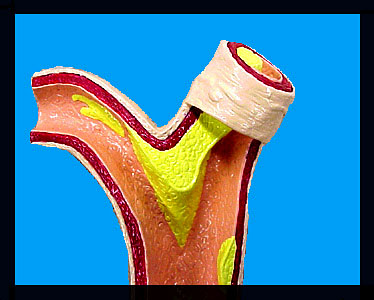|
|
||||||||||||||||||||||||||||||||||||||||||||||||||||||||||||||||||||||||||||||||||||||||||||||||||||||||||||||||||||||||||||||||||||
|
This model shows a section of the coronary artery containing a buildup of fatty deposits called plaque. Such a condition in which the vessels supplying the heart with blood are clogged with plaque is called coronary atherosclerosis. Note how the diameter of the vessel lumen is reduced by the buildup of plaque. If the blockage increases to the point at which circulation to the heart is inadequate to meet tissue needs of this organ, a condition called pectoris angina (chest pains) results. Another risk of coronary atherosclerosis is that of blood clot formation. As blood flows over the abnormal inner lining of the vessel, it may form clots that can block blood vessels in other parts of the body. If blood vessels supplying the brain with oxygen are blocked by such clots, this can result in a stroke (a leading cause of death in the United States). |
|
